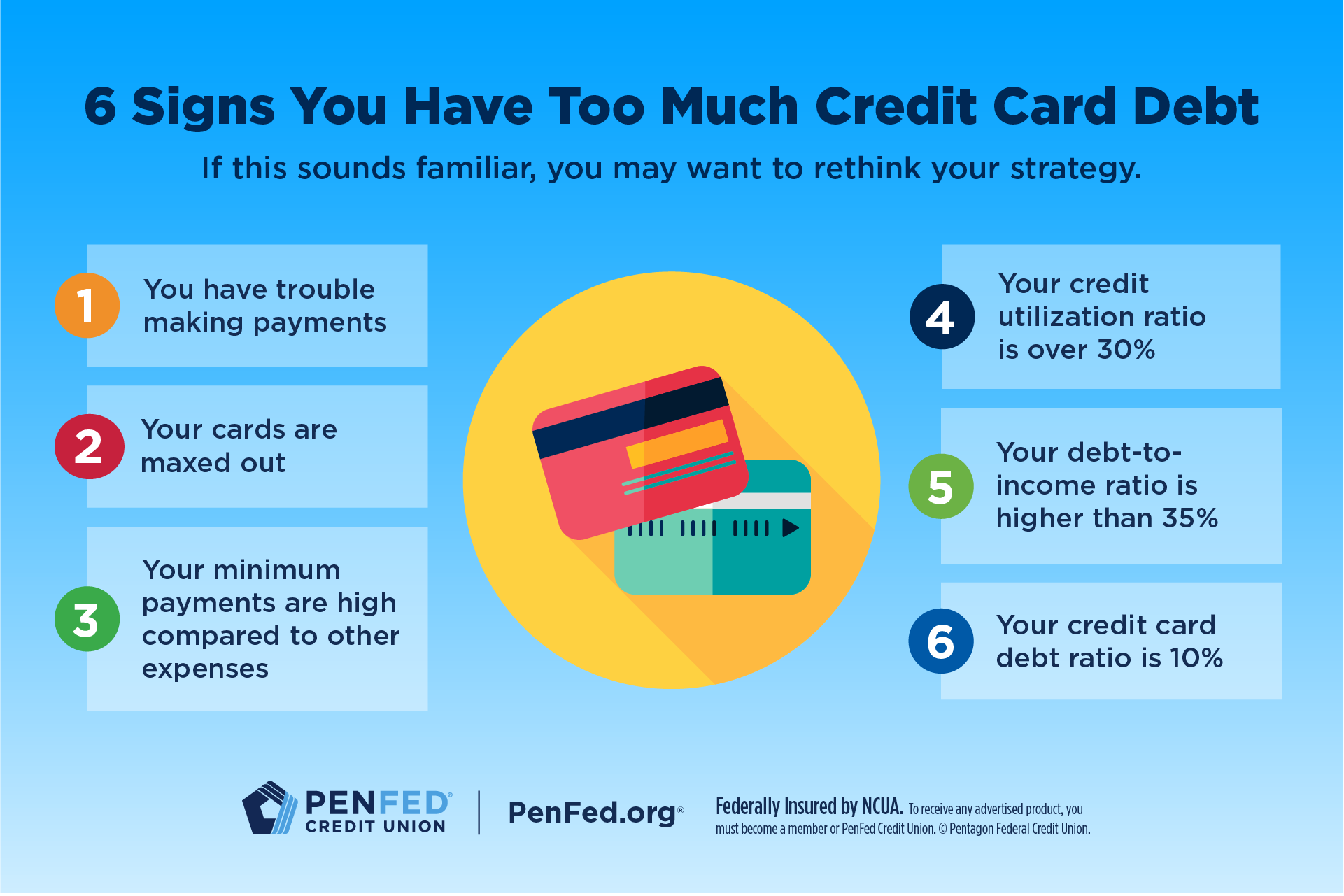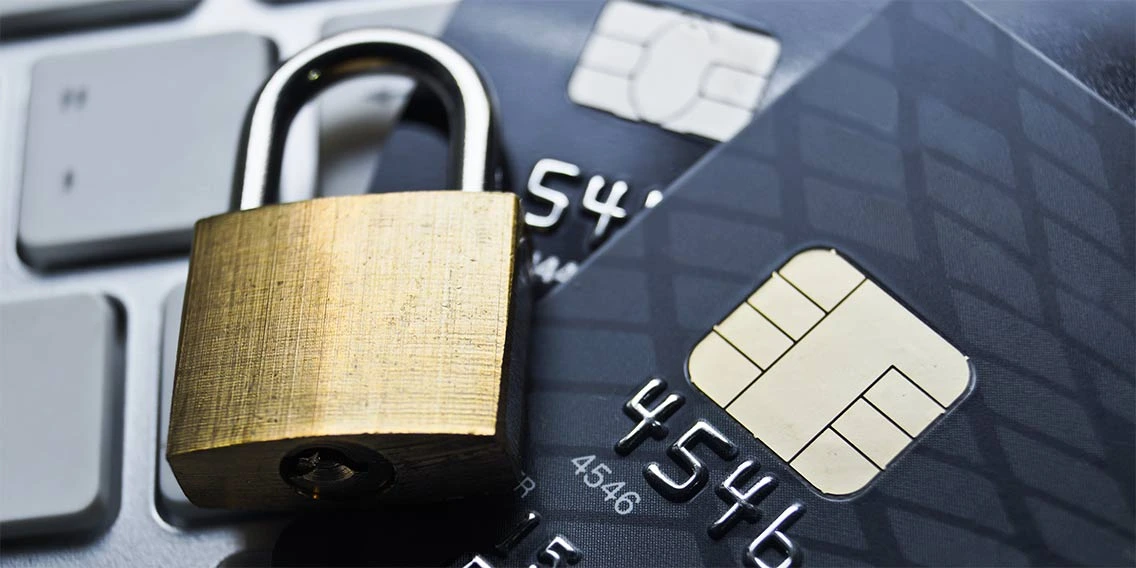Credit Cards
How Much Credit Card Debt Is Too Much?
EXPECTED READ TIME:6 minutes
The answer depends on your financial situation. And while there’s no magic number, there are some formulas that will help you understand how lenders view your debt. By considering your income, lifestyle, and total available credit, you can decide what amount of credit card debt you’re comfortable with.

6 Signs You Have Too Much Credit Card Debt
Credit card debt isn’t always a bad thing. It can help you spread out payments, manage cash flow, and earn cash back or reward points. When chosen wisely and used judiciously, credit cards can build your credit by establishing a long, reliable payment history.
But credit cards are revolving debt, meaning that you’re constantly in a cycle of paying them down and then adding to them again. Along with high interest (compared to other types of loans), this kind of debt has a habit of getting away from you.
Here are six indicators that you have too much credit card debt:
You Have Trouble Making Payments
You might have too much credit card debt if you’re struggling to afford more than minimum payments. Minimum monthly payments for most credit cards only cover interest, fees, and a fraction of your actual balance. If you’re not paying more, then your balance is growing — and may become difficult to pay off.
Using one credit card to pay off others is another sign that you have too much credit card debt. Moving your debt around like this doesn’t resolve the problem and may cost you more in the long term.
Evaluating your credit card debt is a healthy part of financial wellness.
Your Cards Are Maxed Out
If you’re regularly reaching your credit limit on your credit cards, this may indicate a problem. Carrying a high balance could indicate you’re overspending and that reflects badly on your credit score.
You Have High Card Payments
One easy way to evaluate your credit card debt is to compare it to your other bills. If your total payments on all of your credit cards is close to what you pay for non-discretionary expenses like your rent, mortgage, or auto loans then you’re likely carrying too much credit card debt.
Your Credit Utilization Ratio Is High
Credit utilization is a way of measuring how much of your available credit you are using. Anything over 30% credit utilization is considered high and will hurt your credit score — and that goes for your debt per card as well as your total debt overall.
Lower credit utilization is more favorable. In fact, credit utilization is the second biggest factor affecting your credit score. It shows you manage your credit wisely without relying on it to get by.
Credit utilization is the second biggest factor affecting your credit score.
How To Calculate Credit Utilization
To find your credit utilization, add up the total amount you owe on your credit cards and divide that number by your credit limit.
For instance, if you have three credit cards and each has a credit limit of $3,000, then your total available credit is $9,000. Let’s say you owe the following:
- $500 on Card A
- $500 on Card B
- $1,000 on Card C
Your total combined debt is $2,000. If we divide that by your available credit then we get 0.22 — meaning you’re using just under a quarter of your available credit.
Total Combined Debt / Available Credit = Credit Utilization
Ideally, the credit utilization on cards A, B, and C will be under 30% per card, and your overall credit utilization will also be under 30%. In the example above, your overall credit utilization is good at 22%, but Card C is hovering just above the 30% mark. That’s the balance you’ll want to focus on paying down first.
You Have a High Debt-to-Income Ratio
Your debt-to-income ratio is another way to put your credit card debt in context. This ratio compares your total monthly expenses to your monthly pre-tax income. To calculate it, add up all of your monthly bills such as:
- Rent or mortgage
- Auto loans
- Student loans
- Credit cards
- Any other debt you carry
A lower debt-to-income ratio tells lenders you’re more likely to repay what you borrow. Debt-to-income ratios of 35% or less are considered good.
You might have too much credit card debt if you’re struggling to afford more than minimum payments.
How to Calculate Debt-to-Income
Let’s say you’re calculating your debt-to-income ratio. Your monthly pre-tax income is $5,000 and you have the following monthly expenses:
- Mortgage: $1,200
- Car loan: $500
- Credit cards: $300
Your total monthly expenses are $2,000. Divide that by your gross monthly income and you end up with a debt-to-income ratio of 40%.
To manage your debt better, apply for a credit card balance transfer to a card with a lower interest rate.
Limits of Debt-to-Income Ratio
One downside of the debt-to-income ratio is that this ratio accounts for your total debt rather than your credit card debt alone. Many financial experts agree that some debts are “healthier” than credit card debt. For instance, your mortgage or students loans:
- Don’t charge the same interest as a credit card
- Are paid in a set number of installments
- Are less likely to get out of control
- May be partially written off your federal income taxes
While debt-to-income ratio is still a useful tool for evaluating your finances, you’ll get a better sense of how your credit card debt impacts you if you pair it with other evaluative tools.
Credit card payments shouldn’t exceed 10% of your net income.
Credit Card Debt Ratio
A simpler way of evaluating your credit card debt is through your credit card debt ratio. This ratio looks at how much after-tax income you have each month to cover your credit card debt. If your minimum credit card payments are too high, they’ll make it hard to cover your other expenses. Credit card payments shouldn’t exceed 10% of your net income.
Imagine your monthly net income is $4,000 and you have the following minimum payments due on credit cards:
- $75 on Card A
- $120 on Card B
- $50 on Card C
That gives you a total minimum credit card debt of $245 monthly. Dividing by your net monthly incomes shows you have a credit card debt ratio of 6%.
How Much Credit Card Debt Does the Average American Have?
According to a recent study by Experian, the average American carries a credit card balance of $5,315. That’s not an easy sum for most people to pay off quickly, which means most Americans are carrying their balance for a while.
One alternative is a personal line of credit. Known as a PLOC, it’s similar to a credit card in that it’s a revolving line of credit, but a PLOC is only available during a set timeframe and usually comes with a lower interest rate. You’ll draw from it by writing checks instead of swiping a card.
A typical PLOC is available for between six months and five years and provides a credit limit of between $1,000 and $100,000. Most have a monthly repayment schedule.
PLOCs are great for small home remodels, medical expenses, or refinancing loans. Some borrowers also use them to reconsolidate credit card debt.
Personal lines of credit are great for small home remodels, medical expenses, or refinancing loans.
How to Handle Too Much Credit Card Debt
The first step is to evaluate the problem. If you’re overspending, then it’s time to create a budget and stick to it. This may require cutting unnecessary expenses or creating a schedule of your monthly bills so you avoid costly late fees.
Paying more than the minimum monthly payment is also important. If you’ve only been paying the minimums, then you’ll need to adjust your spending so you can increase your monthly payments. Otherwise, you’re only treading water and not making real progress.
Many financial experts agree that some debts are “healthier” than credit card debt.
For many people with high credit card debt, month-to-month payments are simply too high for them to ever pay down the principle. If this sound familiar, you can try a couple of things to make payments more manageable:
- Find additional income such as a part-time job
- Call your credit card lender and ask for a lower interest rate
- Apply for a credit card balance transfer to a card with a lower interest rate or 0% introductory rate
- Consolidate your credit card debt with a type of personal loan called a debt consolidation loan
The Takeaway
Evaluating your credit card debt is a healthy part of financial wellness. By examining your credit card debt in relation to your other finances, you can learn to leverage your credit more effectively, cut expenses, and establish strategies for paying off debt to build a better financial future.
Eliminate Credit Card Debt For Good
Learn a few simple strategies for paying off your cards.




